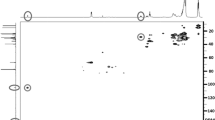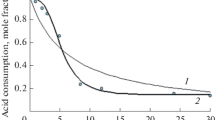Abstract
Hydrolyses of racemic methyl-branched octanoic acid thiolesters are described using six commercial lipases as catalysts. Branching at positions 2, 4 and 5 greatly reduced activity; branching at the 3-position virtually eliminated activity. The reactivities of the racemic branched thiolesters relative to the unbranched ester were very similar for each lipase preparation examined. In reactions involving configurationally pure 2-methyloctanoic acids, the S-enantiomer reacted faster both in esterification of aliphatic alcohols and in hydrolyses of aliphatic alcohol esters with all of the lipases examined. Stereobiases in hydrolyses of the octanoic acid esters branched at other positions were low and variable. In sharp contrast to the hydrolyses of the thiolesters of 2-methyloctanoic acid, two aryl esters of 2-methyloctanoic acid catalyzed byR. miehei lipase hydrolyzed with a bias for the R-configuration. A view of the ester-enzyme complex is offered, to explain the relative rates of reaction of the racemic esters.
Similar content being viewed by others
Abbreviations
- DTNB:
-
5,5′-dithio-bis-(2-nitrobenzoic) acid Ellman's reagent
- ER :
-
enantiomeric ratio, ratio of specificity constants for enantiomers
- GLC:
-
gas-liquid chromatography
- HMPT:
-
hexamethylphosphoric triamide
- IR:
-
infrared
- 2-MOA:
-
2-methyloctanoic acid
- NMR:
-
nuclear magnetic resonance
- R and S:
-
standard conventions for designating configuration
- TLC:
-
thinlayer chromatography
References
Brockman, H.L., Momsen, W.E., and Tsuita, T. (1987)J. Am. Oil Chem. Soc. 65, 891–931.
Kalaritis, P., Regenye, R.W., Partridge, J.J., and Coffen, D.L. (1990)J. Org. Chem. 55, 812–815.
Sonnet, P.E., and Gazzillo J.A. (1990)Org. Prep. Proc. Int. 22, 203–208.
Sonnet, P.E., Gazzillo, J.A., Dudley, R., and Boswell, R.T. (1990)Chem. Phys. Lipids 54, 205–214.
Bradford, M.M. (1976)Anal. Biochem. 72, 248–254.
Sonnet, P.E., and Moore, G.G. (1989)Lipids 24, 743–745.
Sakakibara, S., and Inukai, N. (1964)Bull. Soc. Chem. Japan 37, 1231–1232.
Renard, G., Grimaud, J., El Zant, A., Pina, M., and Graille, J. (1987)Lipids 22, 539–541.
Ellman, G.L. (1959)Arch. Biochem. Biophys. 82, 70–77.
Wharton, C.W., and Eisenthal, A.B. (1981)Molecular Enzymology, pp. 73–98, John Wiley and Sons, New York.
Aarsman, A.J., van Deenen, L.L.M., and van den Bosch, H. (1976)Biorg. Chem. 5, 241–253.
Entressangles, B., and Desnuelle, P. (1968)Biochim. Biophys. Acta 159, 285–295.
Cambou, B., and Klibanov, A.M. (1984)Appl. Biochem. Biotech. 9, 255–260.
Chen, C.-S., Fujimoto, Y., Girdaukas, G., and Sih, C.J. (1982)J. Am. Chem. Soc. 104, 7294–7298.
Martin, V.S., Woodard, S.S., Katsuki, T., Yamada, Y., Ikeda M., and Sharpless, K.B.,J. Am. Chem. Soc. 103, 6237–6240.
Macrae, A.R. (1983) inMicrobial Enzyme and Biotechnology (Fogarty, W.M., ed.), pp. 225–250, Applied Science, New York.
Inada, Y., Takahashi, K., Yashimoto, T., Ajima, A., Matsushima, A., and Saito, Y. (1986)Tibtech, 190–194.
Author information
Authors and Affiliations
Additional information
Reference to a brand or firm name does not constitute endorsement by the U.S. Department of Agriculture over others of a similar nature not mentioned.
About this article
Cite this article
Sonnet, P.E., Baillargeon, M.W. Methyl-branched octanoic acids as substrates for lipase-catalyzed reactions. Lipids 26, 295–300 (1991). https://doi.org/10.1007/BF02537140
Received:
Accepted:
Issue Date:
DOI: https://doi.org/10.1007/BF02537140




